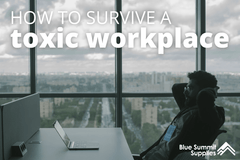Does your team feel safe at work? Do they feel welcome to make suggestions and ask questions? Does each of your coworkers feel comfortable making mistakes without fear of their manager or fellow team members mocking or ridiculing them? If not, it’s a clear sign that your business needs to focus on improving psychological safety in the workplace.
In this post, we’ll break down what psychological safety is and why it’s important, including how you can ensure the psychological safety of your team.
Why is Psychological Safety Important?
Organizational behavioral scientist Dr. Amy Edmondson coined the term psychological safety. It refers to the “belief that one will not be punished or humiliated for speaking up with ideas, questions, concerns, or mistakes.”
High-performing teams need psychological safety. In order for a team member to voice a concern, ask a question, be accountable for a mistake, or share an innovative idea, they need to know they won’t be ridiculed, made fun of, or punished. Building and maintaining this kind of trust and psychological security is paramount to any successful team, as it gives each team member the courage to express themselves and communicate openly.
Not every exciting, innovative idea is going to pan out. In fact, many will fail. But if not a single team member speaks up for fear of being embarrassed or humiliated by their boss or peers, your business will grow stagnant fast.
Not convinced? Google conducted a study to determine what makes their teams successful, and they discovered the most essential factor is psychological safety.
Benefits of Psychological Safety:
- Builds trust among team members
- Inspires innovative ideas
- Enhances employee engagement
- Boosts team effectiveness and efficiency
- Improves the wellbeing and morale of employees
- Promotes an inclusive workplace
- Reduces employee turnover

What is Emotional Safety vs. Psychological Safety?
In psychology, emotional safety refers to feeling secure enough in a relationship to open up, be vulnerable, and express your authentic self. The term is predominantly used to refer to romantic relationships, so emotional safety in the workplace doesn’t quite make sense in this context.
But when people refer to emotional safety at work, they very likely mean psychological safety. In either case, the operative word is ‘safety.’ You want your team to feel comfortable being exactly who they are at work. No member of your team should feel like they need to hide parts of their identity for fear of being judged or ostracized. Do all that you can to ensure every member of your team feels safe in the workplace—emotionally, psychologically, and physically.
How to Ensure Psychological Safety in the Workplace

Practice Active Listening
Believe it or not, there is more than one way to listen. There’s the way you listen to your nephew when he’s explaining the finer points of Minecraft for the seventeenth time, and there’s the way you listen to your future in-laws when you are first introduced to them. How do you demonstrate that they have your full and undivided attention?
This is the difference between active and passive listening. Passive listening is when you half listen to someone while you’re doing something else. How often have you been speaking to someone while they’re on their phone? They may grunt every now and again, but it’s clear they’re not really listening. Like how you might listen to your retired mother gossiping about the neighbors. “Hmm. Fascinating. Yes, they really shouldn’t be parking on the road.” 😴
Passive listening is basically just letting someone have a one-sided conversation with you. Active listening is just the opposite because it takes effort. Giving someone your full and undivided attention takes energy. Active listening involves steady eye contact and verbal responses that demonstrate you’re comprehending the information.
Active listening is all about respect, which is the essence of psychological safety. Why would a member of your team ever feel welcome to speak up if all they ever get from you is, “Hmm? Sorry? What was that? Oh yeah, back to what I was saying.”
When a coworker has something to say, show them you want to hear it by actively listening to their comments and ideas.
📚 Learn more about Active vs. Passive Listening, Active Listening Activities, and Other Effective Ways to Listen.

Be Transparent
Trust is fundamental to psychological safety. If your business has a need to know attitude about information, it’s going to breed distrust. Keeping secrets suggests you have something to hide. Your team members will wonder what you’re keeping from them and why. If they do overhear a piece of information, it could easily be taken out of context and will very likely lead to rumors and gossip spreading throughout the office.
Transparency and open communication, on the other hand, promotes trust and equality. It helps each team member, no matter their position in the company, feel valued and like they’re an important part of the greater whole—which they absolutely are. Transparency leads to peace of mind. No one wants to feel like they’re out of the loop.
Make transparency one of your brand values. Live and breathe integrity, accountability, and authenticity. Your brand values don’t only inspire your team—they affect the prospective employees, customers, and general audience you attract.
📚 Learn more about Transparent Communication in the Workplace.

Accept Failure or Mistakes as Learning Opportunities
You can’t challenge the status quo without innovation, and you can’t have innovation without listening to new ideas and trying new things. Unfortunately, not every new idea is going to work out. There will be mistakes and failures along the way. Does this mean you should stop trying new things and get comfortable with a stagnating status quo? Absolutely not!
Embracing failure as a learning opportunity is a great way to support the psychological safety of your team. As Amy Edmondson says, psychological safety is “a shared belief that the team is safe for interpersonal risk-taking.” If a team member takes a risk and fails and you publicly humiliate them, how likely are they to ever take a risk again? The next time they have an idea, do you think they’ll share it willingly, or are they going to remember their public humiliation and keep their mouth shut?
Mistakes are the only way we learn. Encourage your team to try new things, and if something doesn’t work out, break down the steps together to determine where it went wrong. Managers aren’t there to penalize and ridicule their team members; they’re there to offer support and encouragement. When a team member makes a mistake, help them stand up and dust themselves off, then encourage them to go out there and fail again.

Ask Questions and Gather Feedback
Curious about how psychologically safe your team feels? Don't assume—ask.
Measuring psychological safety can be as simple as gathering feedback with psychological safety questions, but be careful not to put your team members on the spot. Asking a coworker or subordinate point blank if they feel safe expressing themselves is a surefire way to make them feel uncomfortable expressing themselves.
If you’re wondering how to measure psychological safety in a comfortable and tangible way, start by organizing a psychological safety survey. You can go a step further and make your team feel even safer by making the survey anonymous.
Do your team members feel heard? Do they feel like their ideas are shot down too often? Have they had a bad experience expressing themselves in the past? How do they feel about your management style? Is the team as a whole supportive, or are members competitive and resentful of each other? What would they change about the company culture?
You can’t ensure the psychological safety of your team without knowing how safe they currently feel. Even if you’re completely confident that your team feels psychologically safe, ask questions and gather feedback. Hopefully, you’ll be pleasantly surprised, and if not, you know the path you need to take. After all, both life and business are all about continuous improvement.

Invest in Psychological Safety Training for Managers and Leaders
Psychological safety takes work and plenty of it. If you want to improve the psychological safety of your team, practice some psychological safety exercises during your team building sessions.
For example, an “anxiety party” is a game in which each team member writes down their biggest anxieties. Once that’s done, ask your team to rank those anxieties. Once the anxieties have been written down and ranked from least concerning to most concerning, ask your coworkers to share their list with the rest of the team, who can provide encouragement and a different perspective. This promotes empathy in the workplace as well as open and honest communication—the building blocks of a trusting team.
You also don’t have to do it alone. If you don’t know where to begin, there are psychological safety training courses your company can invest in. Psychological safety is key to an innovative, effective, efficient, and accountable team, so an investment in psychological safety training is an investment in the business as a whole.
More From Blue Summit Supplies
💡 How Realistic Optimism Can Replace Toxic Positivity in the Workplace
💡 How to Handle Intimidation at Work
We’re passionate about workplace safety and wellbeing. Follow our office blog for the latest trends, team building strategies, product comparisons, and more.
If you have any questions, leave a comment below or connect with us on Twitter, Facebook, or Instagram.
 For more informative articles about office supplies, subscribe to our email newsletter!
For more informative articles about office supplies, subscribe to our email newsletter!
Never fear, you won't begin receiving daily sales emails that belong in a spam folder. Instead, we promise a fun weekly roundup of our latest blog posts and great finds from across the web. And if you lose interest, it's always easy to unsubscribe with a single click.









